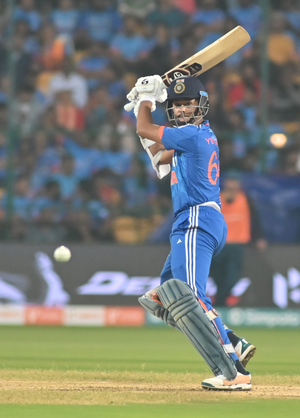Yashasvi Jaiswal, Rachin Ravindra, Phoebe Litchfield, Lauren Bell earn ICC Emerging Player of the Year nominations
New Delhi: Yashasvi Jaiswal, Rachin Ravindra, Phoebe Litchfield and Lauren Bell have earned ICC Emerging Player of the Year nominations for 2023. While Ravindra and Jaiswal are joined by Gerald Coetzee and Dilshan Madushanka in the men’s category, Phoebe and Lauren are accompanied by Marufa Akter and Darcey Carter in the women’s category.
Jaiswal made his Test debut against the West Indies in July, and the left-handed opener made the most of the chance, making 171 in Dominica, laced with 16 fours and a six, and earned Player of the Match accolades. Jaiswal became the 17th player from India to make a century on Test debut, and the seventh India player to achieve the feat away from home.
His 229-run opening stand with captain Rohit Sharma is also the second-highest for India in Tests in the West Indies, and set the tourists up to a total of 421/5 declared, eventually leading their way to a mammoth win. He added 57 and 38 in the second Test of the tour at Trinidad, of which the half-century was made in an opening stand of 139 with Rohit.
Jaiswal further earned a T20I debut in the West Indies, and despite a blip in his first match, he responded with an innings of 84 not out from just 51 balls in the fourth T20I at Lauderhill, Miami, USA.
He posted an even 100 (49) against Nepal in India’s gold-medal winning campaign at the Asian Games in Hangzhou, before slamming half-centuries against Australia (53 from 25 balls) and 60 (41) against South Africa. Though he is yet to get his ODI debut, Jaiswal may have a crack at it in 2024 after entering international scene in 2023.
Ravindra, the left-handed batting all-rounder from New Zealand, made headlines in 2023 for his ODI exploits, a format he debuted in March. He showed glimpses early with a knock of 49 against Sri Lanka to begin, also chiming in with the ball, taking consecutive three-wicket hauls against Pakistan and England, both away from home.
A fifty against England at Lord’s followed, before showing maturity in his 123 not out off 96 balls in New Zealand’s opening match of the Men’s ODI World Cup against England. A knock of 51 against the Netherlands followed, before another half-century against India in a thrilling game in Dharamsala.
Ravindra went on to smash 116 in a spirited chase against Australia at the same venue, before another century against Pakistan in Bengaluru, the hometown of his parents. Ravindra’s 578 runs was the highest tally for a New Zealand player in a single edition of the Men’s ODI World Cup.
Coetzee, the South Africa fast-bowler, became South Africa’s leading wicket-taker in the Men’s ODI World Cup with 20 scalps at an average of 19.80. He also took three wickets in just 18 overs on his Test debut against the West Indies in Centurion in February. In four T20Is, Coetzee went on to claim 6 wickets across 13.2 overs, claiming 3/32 against India in Gqeberha.
Madushanka, the left-arm fast-bowler from Sri Lanka, took 15 ODI wickets at an average of 24.06 and economy rate of 6.09. His highlight of the year came in the ODI World Cup, where he took 21 wickets, including 5-80 against India in Mumbai. He also took 12 T20I wickets at an average of 29.41 and economy rate of 9.80.
In the women’s category, Phoebe started the year in great touch as she smashed consecutive unbeaten half-centuries in her first two ODI matches at home against Pakistan. Despite narrowly missing out on selection for Australia’s squad at the ICC Women’s T20 World Cup, Litchfield returned to international action with a Player of the Match performance by hitting her first century in international cricket with an unbeaten 106 against Ireland in Dublin.
She then smashed five sixes and an unbeaten 52 from just 19 deliveries in her first T20I contest of the year against the West Indies at the start of October, before taking Player of the Series award in Australia’s recent 3-0 ODI series win over India, including a fine 119 at the Wankhede Stadium.
Lauren became the premier pacer in England’s setup following the retirement of fast-bowling stalwart Katherine Sciver-Brunt. She picked up three wickets from four appearances during the ICC Women’s T20 World Cup in February and then performed admirably in all three formats during England’s multi-format Ashes series against Australia in July.
Marufa, the Bangladesh fast-bowler, caused a major scare for Sri Lanka’s batting order in the Women’s T20 World Cup as she picked up two wickets in consecutive balls and three for the match while collecting impressive figures of 3/23 in just her third T20I contest.
She then got the prized scalp of Beth Mooney in her next match at the T20 World Cup when taking on powerhouse Australia, before finishing the tournament with a total of four wickets and a tidy economy rate of 6.31.
Marufa, 18, again shined with figures of 4/29 in an ODI against India in July, as Bangladesh defended 152, and has become a regular in the Bangladesh team for their series against Pakistan and South Africa.
Darcey, on the other hand, made 224 T20I runs at an average of 22.40 and even picked 13 scalps with her off-spin bowling while averaging 12.07. She was called up to the senior team in July, taking part in a T20I tri-series with Thailand and the Netherlands in Utrecht, after playing in the U19 Women’s T20 World Cup.
–IANS


Comments are closed.